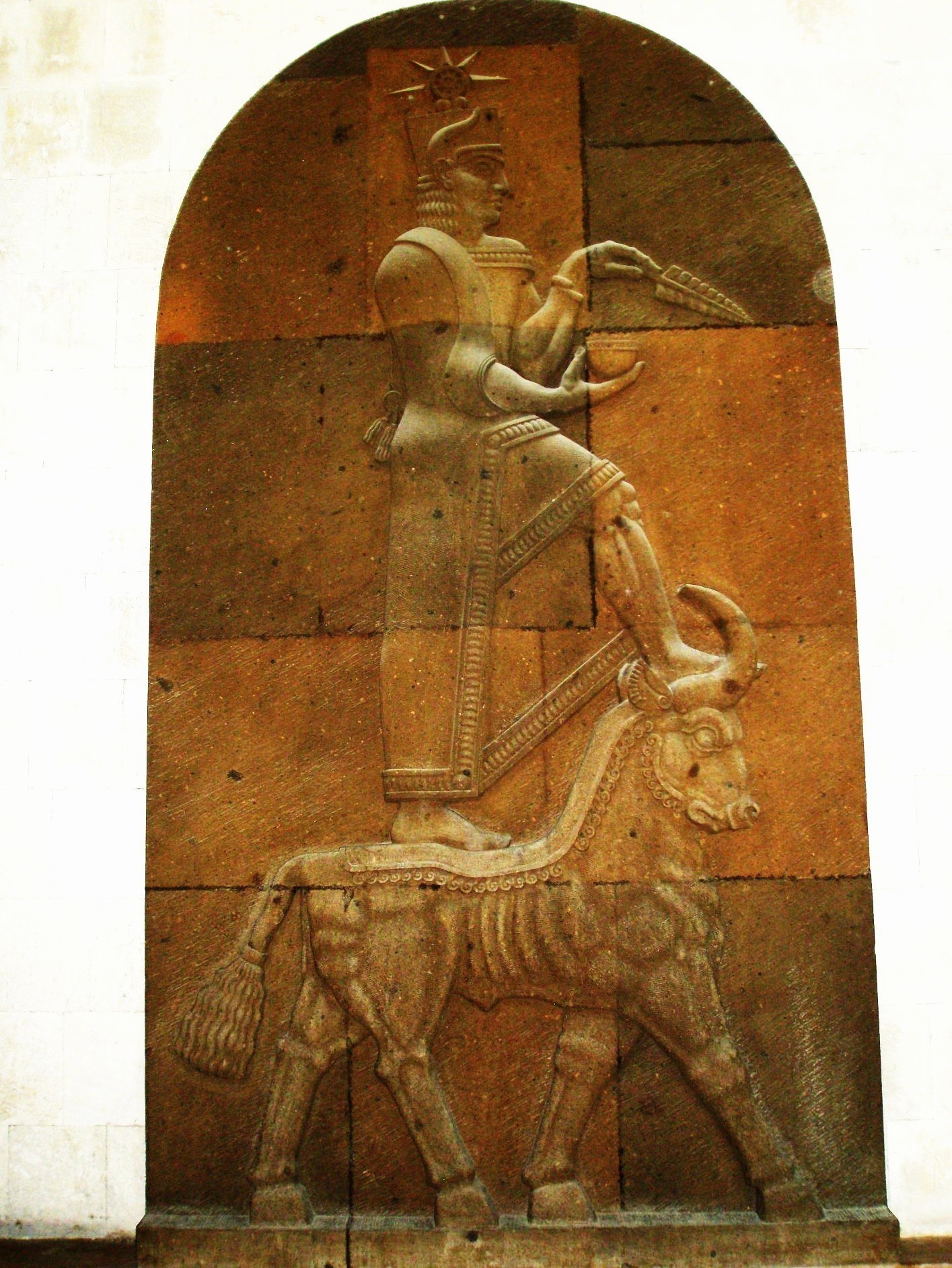Theispas on:
[Wikipedia]
[Google]
[Amazon]
 ''Theispas'' (also known as
''Theispas'' (also known as
Teisheba
''Theispas'' (also known as Teisheba or Teišeba) of Kumenu was the Araratian (Urartian) weather-god, notably the god of storms and thunder. He was also sometimes the god of war. He is the son of Habli. He formed part of a triad along with Kh ...
or Teišeba) of Kumenu Kummanni ( Hittite: ''Kummiya'') was the name of the main center of the Anatolian kingdom of Kizzuwatna. Its location is uncertain, but it may have been near the classical settlement of Comana in Cappadocia.
Recent research also proposed as a loca ...
was the Araratian (Urartian) weather-god, notably the god of storms and thunder. He was also sometimes the god of war. He is the son of Habli. He formed part of a triad along with Khaldi and Shivini
Shivini ( xur, 𒀭𒅆𒄿𒌑𒄿𒉌, translit=dši-i-u2-i-ni), also known as Siuini, Artinis, Ardinis, was a solar god in the mythology of the Iron Age kingdom of Urartu in the Armenian Highlands. He is the third god in a triad with Khaldi ...
. The ancient Araratian cities of Teyseba
Odzaberd ( hy, Oձաբերդ; meaning "Serpent's Fortress"; formerly Teyseba referring to the Urartian fortification and named after the god Teisheba; also known as Ishkanaberd meaning "Lord's Fortress") is located upon a hill east of the town of ...
and Teishebaini
Teishebaini (also Teshebani, modern Karmir Blur ( hy, Կարմիր Բլուր) referring more to the hill that the fortress is located upon) was the capital of the Transcaucasian provinces of the ancient kingdom of Urartu. It is located near the ...
were named after Theispas. He is a counterpart to the Assyrian god Adad
Hadad ( uga, ), Haddad, Adad (Akkadian: 𒀭𒅎 '' DIM'', pronounced as ''Adād''), or Iškur ( Sumerian) was the storm and rain god in the Canaanite and ancient Mesopotamian religions.
He was attested in Ebla as "Hadda" in c. 2500 BCE. ...
, the Vedic God Indra
Indra (; Sanskrit: इन्द्र) is the king of the devas (god-like deities) and Svarga (heaven) in Hindu mythology. He is associated with the sky, lightning, weather, thunder, storms, rains, river flows, and war. volumes/ref> I ...
, and the Hurrian god, Teshub
Teshub (also written Teshup, Teššup, or Tešup; cuneiform ; hieroglyphic Luwian , read as ''Tarhunzas'';Annick Payne (2014), ''Hieroglyphic Luwian: An Introduction with Original Texts'', 3rd revised edition, Wiesbaden: Harrassowitz Verlag, p.& ...
. He was often depicted as a man standing on a bull, holding a handful of thunderbolts. His wife was the goddess Huba, who was the counterpart of the Hurrian goddess Hebat.
See also
*Teshup
Teshub (also written Teshup, Teššup, or Tešup; cuneiform ; hieroglyphic Luwian , read as ''Tarhunzas'';Annick Payne (2014), ''Hieroglyphic Luwian: An Introduction with Original Texts'', 3rd revised edition, Wiesbaden: Harrassowitz Verlag, p.& ...
*Urartu
Urartu (; Assyrian: ',Eberhard Schrader, ''The Cuneiform inscriptions and the Old Testament'' (1885), p. 65. Babylonian: ''Urashtu'', he, אֲרָרָט ''Ararat'') is a geographical region and Iron Age kingdom also known as the Kingdom of Va ...
*Teispes
Teïspes (from Greek ; in peo, 𐎨𐎡𐏁𐎱𐎡𐏁 ''Cišpiš''; Akkadian: 𒅆𒅖𒉿𒅖 ''Šîšpîš'',Kent (1384 AP), page 394 Elamite: Zi-iš-pi-iš) ruled Anshan in 675–640 BC. He was the son of Achaemenes of Persis and an ancest ...
References
Urartian deities Sky and weather gods {{Armenia-hist-stub